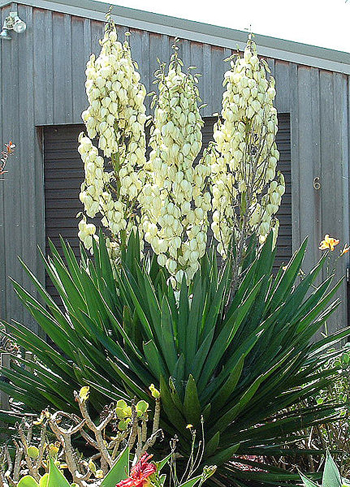Contents:
Common Names | Parts Usually Used | Plant(s) & Culture | Where Found | Medicinal Properties | Biochemical Information
Legends, Myths and Stories | Uses | Formulas or Dosages | How Sold | Warning | Bibliography
Scientific Names

- Yucca filamentosa L.
- Yucca glauca
- Liliaceae
- Lily family
Common Names
- Adam’s needle
- Soapweed
- Spanish needle
Parts Usually Used
Roots
Back to Top
Description of Plant(s) and Culture
Yucca filamentosa L.: A perennial, to 9 feet in flower. Leaves in a rosette; stiff, spine-tipped, oblong to lance-shaped, with fraying, twisted threads on the margins. Flowers whitish green bells on smooth branched stalks; June-September.
Yucca glauca: Blue-green perennial, 2-4 feet tall. Leaves in a rosette; stiff, sword-like; rounded on the back, margins rolled in. Flowers whitish bells; May-July.
Both species are recognized by their sword-shaped, stiff, sharp-tipped leaves. The bell-like flowers are in an erect spike.
Back to Top
Where Found
Yucca filamentosa L.: Sandy soils in southern New Jersey to Georgia. Cultivated elsewhere.
Yucca glauca: Dry soils. Iowa to Texas; Missouri to North Dakota.
Back to Top
Medicinal Properties
Anti-inflammatory, antirheumatic, laxative, alterative in both cases
Back to Top
Biochemical Information
Saponins<. br>
Back to Top
Legends, Myths and Stories
The root is split lengthwise before drying (it should be used only after it has been dried). At one time it was considered an important source of phytosterols and used in the manufacturing of steroidal hormones.
Back to Top
Uses
Yucca filamentosa L., and Yucca glauca:
A sweet herb used for gout and beneficial in treatment of urethritis and prostatitis. A blood purifier . Reduces inflammation of the joints, helpful for arthritis, neuritis, neuralgia, and rheumatism.
Cut up in water to make a natural lather as a soap substitute, can add to shampoos, or can use alone to wash hair. Said to control dandruff and relieve baldness. (1 cup chopped root soaked in 2 cups of water). The roots can be chopped and soaked in water to extract a soapy substance the western Native Americans used for washing. The shoots of the plant can be the Native Americans as a stimulating tonic.
Also, they poulticed root on inflammations, sores, skin diseases, used it to stop bleeding; in steam bath for sprains and broken limbs. Leaf juice used to make poison arrows. Pounded roots were put in water to stupefy corralled fish so they would float to the surface for easy harvest.
Some clinics in the Sonoran desert region of Arizona routinely prescribe yucca against arthritis, with impressive results. (These findings have been disputed)
Back to Top
Formulas or Dosages
1/4 oz. of dried root boiled in a pint of water for 15 minutes may be taken in 3-4 doses throughout the day. It has the ability of relieving pain for several days.
A good general arthritis formula is as follows:
- Yucca root (6 parts)
- Devil’s claw (4 parts)
- Black cohosh root (3 parts)
- Prickly ash bark (2 parts)
- Ginger root (2 parts)
- Licorice root (2 parts)
Make into a standard decoction and take 1 cup 2-3 times daily.
The quantity of yucca root taken by itself is about 1/2 oz. per day.
Back to Top
How Sold
Capsules
Back to Top
Warning
Occasionally there are some purgative side effects that may be accompanied by intestinal cramping. This can be prevented by adding as an antidote some ginger and prickly ash bark, which also will aid its antiarthritic properties. Long term use is said to slow absorption of fat-soluble vitamins, but these findings require further study.
Root compound (saponins) are toxic to lower life forms.
Back to Top
Bibliography
![]() The Herb Book
The Herb Book, by John Lust, Bantam Books, 666 Fifth Avenue, New York, NY. copyright 1974.
![]() The Herbalist Almanac
The Herbalist Almanac, by Clarence Meyer, Meyerbooks, publisher, PO Box 427, Glenwood, Illinois 60425, copyright 1988, fifth printing, 1994
![]() Eastern/Central Medicinal Plants
Eastern/Central Medicinal Plants, by Steven Foster and James A. Duke., Houghton Mifflin Company, 215 Park Avenue South, New York, NY 10000
![]() Planetary Herbology
Planetary Herbology, by Michael Tierra, C.A., N.D., O.M.D., Lotus Press, PO Box 325, Twin Lakes. WI 53181., Copyright 1988, published 1992
![]() Prescription for Nutritional Healing, Fifth Edition: A Practical A-to-Z Reference to Drug-Free Remedies Using Vitamins, Minerals, Herbs & Food Supplements
Prescription for Nutritional Healing, Fifth Edition: A Practical A-to-Z Reference to Drug-Free Remedies Using Vitamins, Minerals, Herbs & Food Supplements, by James F. Balch, M.D. and Phyllis A. Balch, C.N.C., Avery Publishing Group, Inc., Garden City Park, NY
![]() Webster’s New World Dictionary
Webster’s New World Dictionary, Third College Edition, Victoria Neufeldt, Editor in Chief, New World Dictionaries: A Division of Simon & Schuster, Inc., 15 Columbus Circle, New York, NY 10023
 A Useful Guide to Herbal Health Care
A Useful Guide to Herbal Health Care, HCBL (Health Center for Better Living).,1414 Rosemary Lane, Naples, FL 34103., Special Sale Catalog, 1996
 The Rodale Herb Book: How to Use, Grow, and Buy Nature’s Miracle Plants (An Organic gardening and farming book)
The Rodale Herb Book: How to Use, Grow, and Buy Nature’s Miracle Plants (An Organic gardening and farming book), edited by William H. Hylton, Rodale Press, Inc. Emmaus, PA, 18049., 1974
